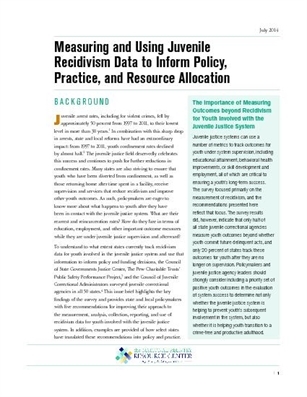Measuring and Using Juvenile Recidivism Data to Inform Policy, Practice, and Resource Allocation
Published Jul 28, 2014, Council of State Governments Justice Center
Download
(693 KB)

Juvenile arrest rates, including for violent crimes, fell by approximately 50 percent from 1997 to 2011, to their lowest level in more than 30 years. In combination with this sharp drop in arrests, state and local reforms have had an extraordinary impact: from 1997 to 2011, youth confinement rates declined by almost half. The juvenile justice field deservedly celebrates this success and continues to push for further reductions in confinement rates. Many states are also striving to ensure that youth who have been diverted from confinement, as well as those returning home after time spent in a facility, receive supervision and services that reduce recidivism and improve other youth outcomes. As such, policymakers are eager to know more about what happens to youth after they have been in contact with the juvenile justice system. What are their rearrest and reincarceration rates? How do they fare in terms of education, employment, and other important outcome measures while they are under juvenile justice supervision and afterward?
To understand to what extent states currently track recidivism data for youth involved in the juvenile justice system and use that information to inform policy and funding decisions, the Council of State Governments Justice Center, The Pew Charitable Trusts’ Public Safety Performance Project, and the Council of Juvenile Correctional Administrators surveyed juvenile correctional agencies in all 50 states. This issue brief highlights the key findings of the survey and provides state and local policymakers with five recommendations for improving their approach to the measurement, analysis, collection, reporting, and use of recidivism data for youth involved with the juvenile justice system. In addition, examples are provided of how select states have translated these recommendations into policy and practice.